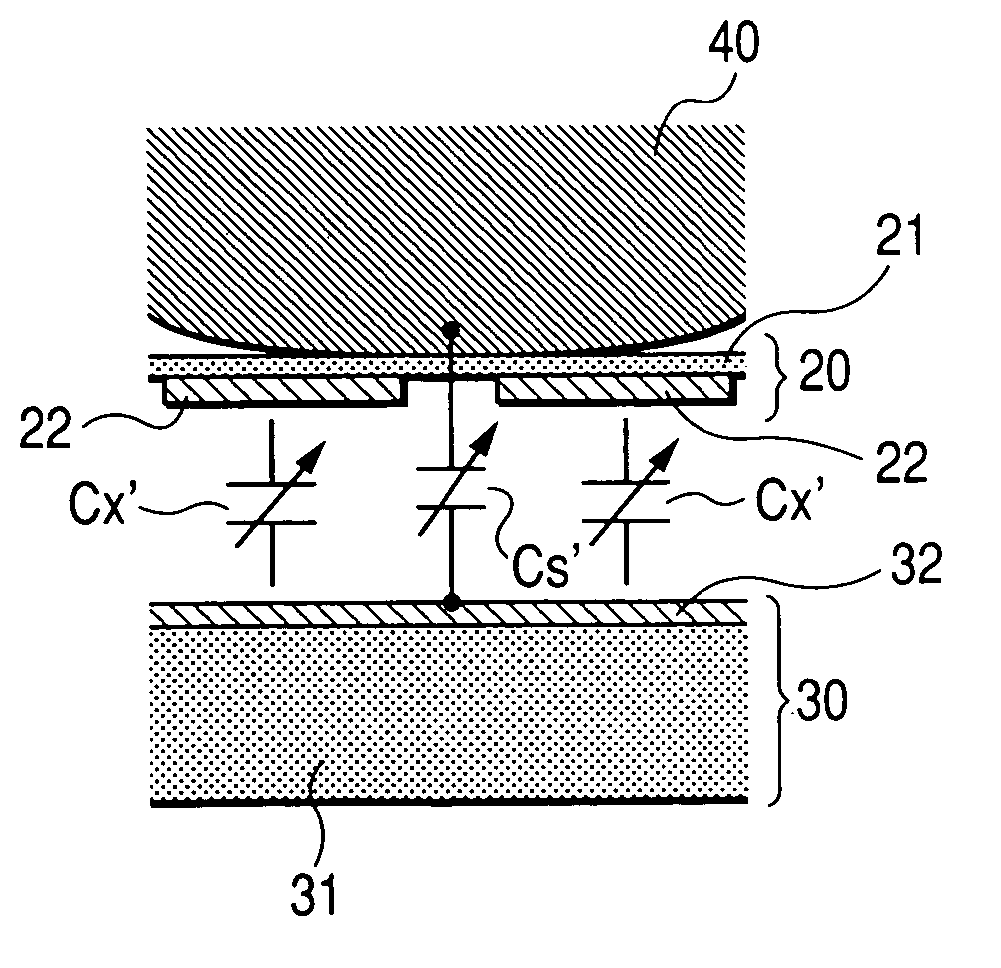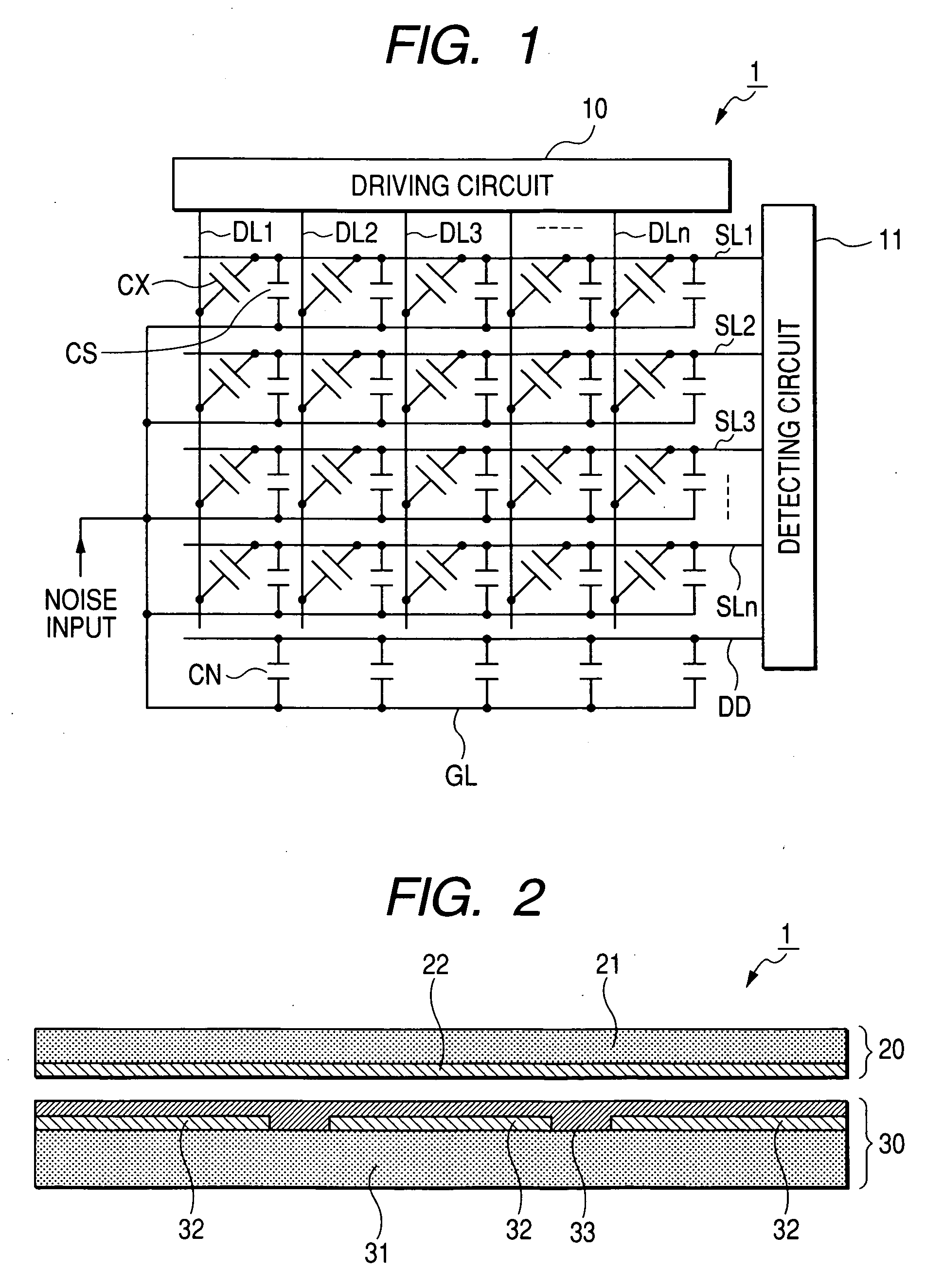Capacitive sensor
a capacitive sensor and sensor technology, applied in the direction of acceleration measurement using interia force, instrumentation, person identification, etc., can solve the problems of reducing the detecting accuracy, unable to remove the noise flowing in from the human body, etc., and achieve the effect of simplifying the structure of the detecting circuit for carrying out the subsequent signal processing and easy removal of the noise delivered from the human body
- Summary
- Abstract
- Description
- Claims
- Application Information
AI Technical Summary
Benefits of technology
Problems solved by technology
Method used
Image
Examples
first embodiment
[0056]FIG. 5 shows a structure of the pressure-sensitive capacitive sensor according to a first embodiment of the invention. Meanwhile, since the gist of the invention lies in the structure of the capacitive sensor, the gist of the invention is not limited to the present embodiment, and the electric structure is omitted in each embodiment. FIG. 5A is a plan view seen from the first substrate 20 (film shaped substrate) of the capacitive sensor, and FIG. 5B is a cross-sectional view taken along B-B′ line of FIG. 5A. The Same reference numerals are attached to the same members as those of the capacitive sensor shown in FIGS. 2 to 4.
[0057] The pressure-sensitive capacitive sensor 1 according to the first embodiment of the invention includes the first substrate 20 where a plurality of vertical wiring lines 22 is formed; and the second substrate 30 where a plurality of horizontal wiring lines 32 is formed. The first and second substrates face each other with a spacer 45 interposed thereb...
second embodiment
[0066] Next, FIG. 6 shows a structure of the pressure-sensitive capacitive sensor according to the second embodiment of the invention. FIG. 6A is a plan view of the sensor unit of the capacitive sensor, and FIG. 6B is a cross-sectional view taken along line C-C′ of FIG. 6A.
[0067] The capacitive sensor according to the second embodiment differs from the capacitive sensor according to the first embodiment in that vertical wiring lines and the horizontal wiring lines are divided into two areas in the first and second substrates, respectively, and are disposed in a matrix, and the horizontal wiring line 50 for noise detection is disposed at a position corresponding to an interface (i.e. central position) between the two areas in the second substrate 30 such that it does not cross the vertical wiring lines, and the rest structures are the same thereby overlapping descriptions will be omitted.
[0068] In FIG. 6, same reference numerals are applied to the same components as the capacitive ...
third embodiment
[0072] Next, FIG. 7 shows a structure of the pressure-sensitive capacitive sensor according to a third embodiment of the invention.
[0073]FIG. 7A is a plan view of the sensor unit of the capacitive sensor, and FIG. 7B is a cross-sectional view taken along line D-D′ of FIG. 7A.
[0074] The capacitive sensor according to the third embodiment differs from the capacitive sensor according to the second embodiment in that vertical wiring lines and horizontal wiring lines are divided into two areas having the inclined area used as an interface area between the two areas, thereby the wiring lines are disposed in a matrix, and the horizontal wiring line 60 for noise detection is formed at a position corresponding to the interface area between the two areas in the second substrate 30 not to cross the vertical wiring lines. Since the rest structures are the same as those of the fourth embodiment, the descriptions thereabout will be omitted.
[0075] In FIG. 7, the first substrate 20 is divided in...
PUM
 Login to View More
Login to View More Abstract
Description
Claims
Application Information
 Login to View More
Login to View More - R&D
- Intellectual Property
- Life Sciences
- Materials
- Tech Scout
- Unparalleled Data Quality
- Higher Quality Content
- 60% Fewer Hallucinations
Browse by: Latest US Patents, China's latest patents, Technical Efficacy Thesaurus, Application Domain, Technology Topic, Popular Technical Reports.
© 2025 PatSnap. All rights reserved.Legal|Privacy policy|Modern Slavery Act Transparency Statement|Sitemap|About US| Contact US: help@patsnap.com



